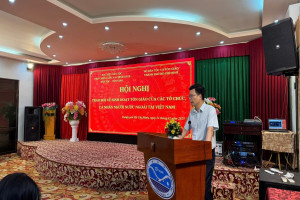
In recent years, our Party, State and governments at all level have taken care of the restoration of religious heritages, relics and building. Since construction law and law on cultural heritage were enforced, the restoration of religious heritage, relics and building has obeyed the law and preserved cultural identity of nation.
At present, in the whole country there are 40.000 relics including 3000 national relics and 5 000 relics at provincial and city level. Every year, tens of national relics are reconstructed with the help of the Sate. Many relics at provincial and city level are reconstructed. Thanks to the grant of the State, charitable organizations and people, many religious relics and heritages are restored The restoration of religious relics and heritages are carried out according to construction law. After restoring, religious relics, heritages and buildings still keep their ancient architecture and cultural identities.
However, the restoration of religious relics, heritages and buildings still has shortcomings and some problems that need to be interested in
1- A wrong awareness of restoration: Restoration of religious heritage, relics and buildings is an important problem which is defined by law on cultural heritage. The main problem of restoration is to maintain ancient architectures of heritages, relics without deforming or introducing new materials. Because the national budget for restoration is limited, some people devote money to restore religious heritages and relics. They do not obey law on cultural heritage. After being restored, some heritages and relics are not preserved their ancient architectures.
2- Sate management on restoration of religious heritage, relics and building is still weakness. The propagation of law on cultural heritage is not good. So some people encroach land of heritage or break the regulations on restoration of religious heritages, relics and buildings. The management of religious relics, heritages and buildings is not close. Religious relics and heritages are not examined so many religious relics and heritages are downgraded. In some cases, the management of religious relics, heritages and buildings is not assigned clearly. Some people who take care of religious relics, heritages and buildings do not have knowledge of law, history and culture. Some monks who manage national temples have not management standard so they often violate law on religious heritage
3- Because of lack of the State’s policy and law, the presiders of religious relics, heritages and buildings often break regulations on building. When restoring religious relics they have not the advice of professional bodies , the plan of restoration and budget forecast. Sometimes they have not license for restoration of religious relics, heritages and buildings.
4- The management of building investment is not close and democratic to cause internal contradiction. At present, the restoration of religious relics, heritages and buildings has negative and active aspects . The active aspect: many people and organizations help and invest money in restoration of religious relics, heritages and buildings. The negative aspect: ancient architecture and traditional cultural identity of many religious relics, heritages and buildings are demolished or rebuilt according to desire of people who invest money to restoration.
5- The technical management of restoration of religious relics, heritages and buildings is not cared about. Building workers have not experience in restoration of religious relics, heritages and buildings.
6- Above problems are showed clearly in restoration of Tram Gian temple in Chuong My, Ha Noi. After temple is downgraded, people contribute their money to restoration this temple. Government officials from commune to Ministry of Culture do not know how temple is restored. When examining inspector find that restoration of this temple change ancient architecture of temple . It manifests the weakness of state management in restoration of religious relics, heritages and buildings as well as in propaganda law on cultural heritage. It is experienced lesson of State management on restoration religious relics, heritages and buildings.
From this reality, the restoration of religious relics, heritages and buildings needs to carry out following problems well
1- To strengthen the propaganda of guideline, law of the State and Party on religious relics, heritages and buildings, especially the law on cultural heritage.
- To propagate the principles, procedure and process of restoration of religious relics, heritages and buildings.
- To report the investment and project of restoration of religious relics, heritages and buildings.
- The restoration of religious relics, heritages and buildings should be supervised, examined regularly.
- The ancient architectures of religious relics, heritages and buildings should be preserved
2- The State management on restoration of religious relics, heritages and buildings must pay attention to following problems
- State bodies should guide and control restoration of religious relics, heritages and buildings.
Any company who undertakes to restore of religious relics, heritages and buildings must submit its plan, design and estimate of expenditure to appropriate authorities.
The downgraded religious relics, heritages and buildings should be restored firstly
The supervision and examination of religious relics, heritages and buildings and process of restoration of religious relics, heritages and buildings. should be reinforced. Every year, officer who undertakes to manager religious relics, heritages and buildings must make a report on quality and actuality of religious relics, heritages and buildings. State managements at all levels should make an examination of religious relics, heritages and buildings and have restoration plan. State managements at all levels should discover and correct timely shortcomings of restoration
3- Division of work and responsibilities on management and restoration of religious relics, heritages and buildings should be clearly to avoid the case of Tram Giam temple. The good division of responsibility will contribute to preservation of national cultural heritages. State management body should promulgate regulations such as: the regulation on management of investment and charitable fund so that charitable organization is not allowed to restore religious relics, heritages and buildings free ; the regulation on maintenance and preservation of religious relics, heritages and buildings should define the responsibility of locality and manager. State management should stipulate that national heritages and relics are managed by the Ministry of Culture, Sports and Tourism so localities, districts communes have not right to restore national heritages and relics in their regions
4- Training and upgrading of officers dealing with preservation of religious heritages, relics and buildings should be enhanced so they can understand law, history, culture and fine arts. These officers must have responsibility, professional knowledge and virtuous character so that the restoration of religious heritages, relics and building is carried out in according the policy, guideline and law of the State and Party.
5- If restoration of religious heritages, relics and buildings would like to achieve good results, we should consolidate the management board of project, select talented workers and reject prolix procedure. We should consolidate files of religious heritages, relics and building because these files are bases for workers to keep ancient architectures and cultural identities of religious heritages, relics and buildings.
6- Ministry of Culture and Tourism, Vietnamese religious organizations and appropriate authorities should make a united on function, duty and the right to restoration religious heritages, relics and buildings, at the same time some points of law on cultural heritages should be corrected in according to current condition
These above problems of State management on restoration of religious heritages, relics and buildings If we carry out well the tasks that mentioned above, we hope the restoration religious heritages, relics and building will be carried out in according to the State’s law and keep ancient architecture and national cultural identity.
Nguyễn Hồng Chương




